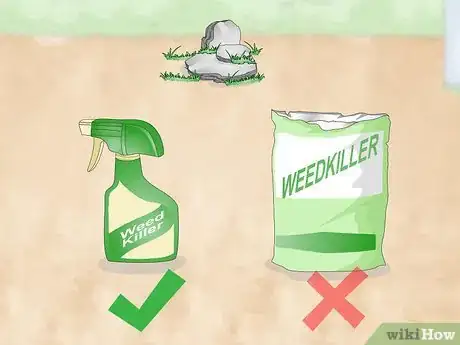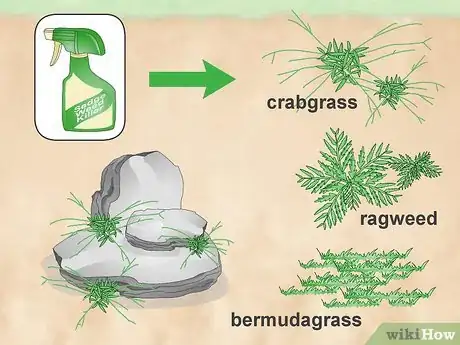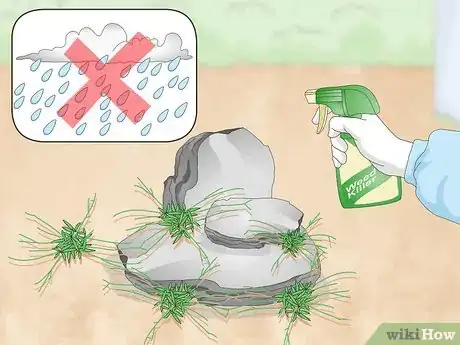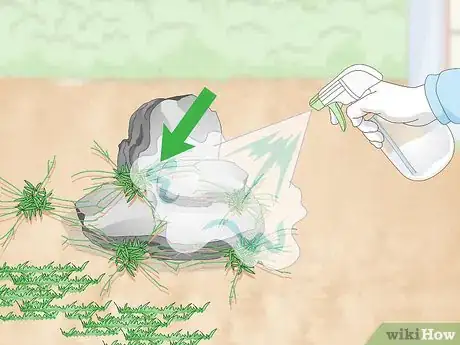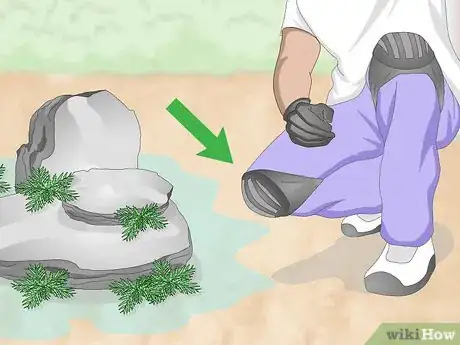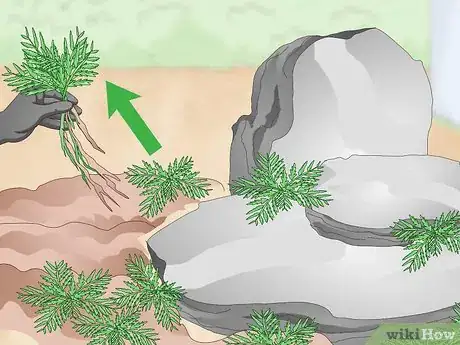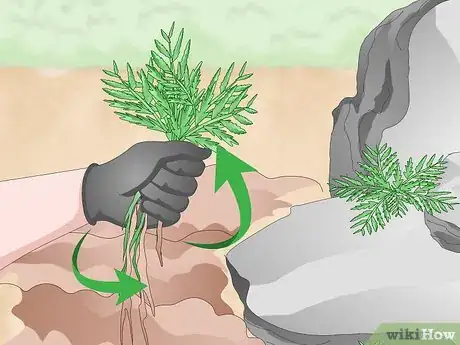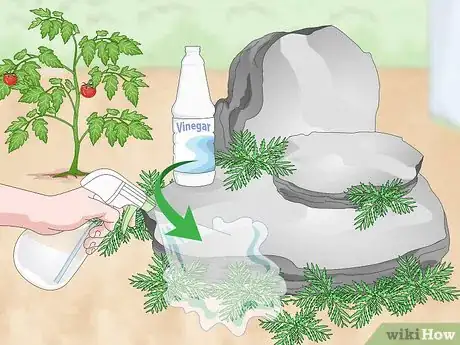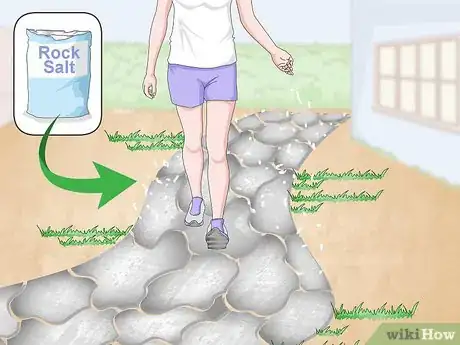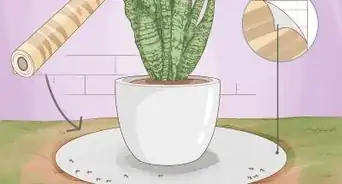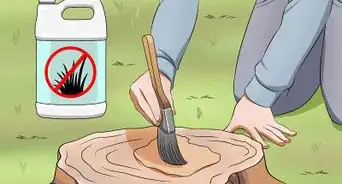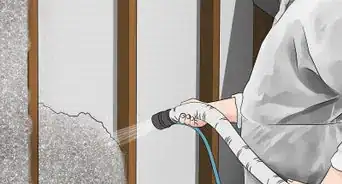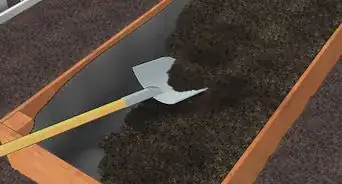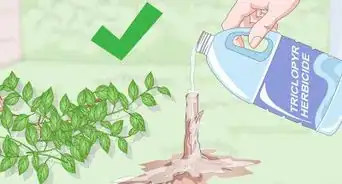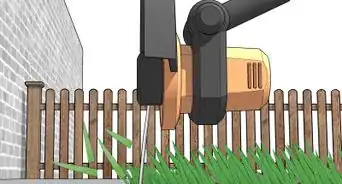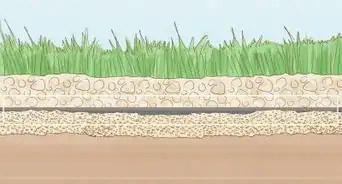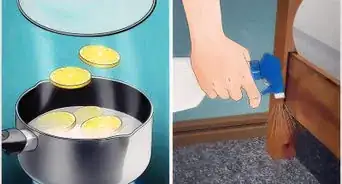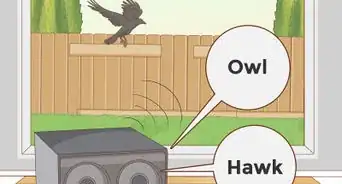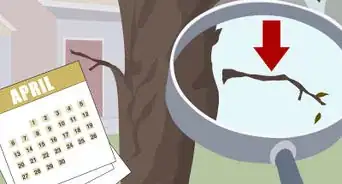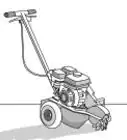This article was co-authored by Lauren Kurtz and by wikiHow staff writer, Hunter Rising. Lauren Kurtz is a Naturalist and Horticultural Specialist. Lauren has worked for Aurora, Colorado managing the Water-Wise Garden at Aurora Municipal Center for the Water Conservation Department. She earned a BA in Environmental and Sustainability Studies from Western Michigan University in 2014.
There are 15 references cited in this article, which can be found at the bottom of the page.
This article has been viewed 66,798 times.
Even through rock mulch and gravel, weeds will somehow find a way to grow. Luckily for you, these can be handled like weeds in any other part of your garden. You can spray a chemical killer, pull them by hand, or use a variety of household materials to help keep your yard free of these plant pests.
Steps
Spraying Chemical Weed Killers
-
1Purchase liquid spray rather than granules. Granular herbicides usually cover a wider area than desired, especially if there are other plants in the area. Purchase a liquid spray weed killer to easily spot treat for weeds.[1]
- Liquid sprays are available as an all-in-one product or in a concentrated form to be mixed with water. Either product will work in this instance.
-
2Select the killer depending on which weeds are present. Specific weeds will react differently depending on the product that you choose. Some weed killers will only target specific styles of plants, so determine which types are present in your rock beds.
- Broadleaf weeds, like clover, dandelions and ragweed, can be targeted separately with a broadleaf killer without damaging any other grasses.[2]
- Grassy weed killer will target Bermudagrass and others, but it is not selective and will your lawn if it comes into contact with it.[3]
- Sedge weed killers will help take care of crabgrass and is specific to this type of weed. Most plants like this form from bulbs, so it may take multiple sprays to fully remove them.[4]
- Non-selective sprays will kill everything they are applied to. This will also include plants that you have planted and your lawn, so use non-selective spray sparingly.[5]
Advertisement -
3Cover up with clothing to protect your skin. Cover as much skin as possible before using weed killer. Wear closed-toe shoes, long pants, and sleeves. Use eye protection, like glasses, sunglasses, or goggles. Don't forget the garden gloves!
- To make sure you are using the weed killer safely, always read the label before you begin.
-
4Spray on a dry day when rain is not expected. Typically, late summer or early autumn is the best time to spray as the weather is fairly consistent.[6] Check the weather to be sure it will not rain within 6 hours of you spraying.[7]
- If you want a weed-free garden all summer, spray in the late spring or early summer instead. It will also reduce weeds before they grow out of control.
-
5Pour 10 milliliters of weed killer per 1 liter of water into a sprayer. If using an herbicide concentration, mix 10 mL of the solution per 1 liter of water.[8] Mix the solution well by swishing it in the sprayer.
- Always follow the label instructions closely to determine how much concentrate to add.
-
6Apply the liquid to the weeds with the sprayer. Thoroughly spray the weeds you are targeting until the leaves are completely wet. The weed killer will penetrate through the leaves deeper into the plant.[9]
- While some weeds may die within hours, some may take a few days to fully die.
-
7Respray the weeds in one week if they are still alive. Some weeds are resilient and will need to be sprayed multiple times before they completely die.
Pulling Weeds by Hand
-
1Water the weeds to loosen the root system. If the entirety of the root system isn’t removed, it’s possible that the weeds will regrow and return. Wait one or two days after you water or after it rains heavily so the soil has time to soak.[10]
- Pulling weeds from wet soil will disturb surrounding plants less than dry soil.[11]
-
2Wear knee pads and gloves to protect your body. Instead of kneeling on hard ground or rocks, wear knee pads to prevent soreness and stiffness later. Gloves will help stop any skin irritation and can also prevent blisters from long days of pulling weeds.[12]
-
3Loosen weeds with a soil knife or garden fork. This will make the weeds easier to pull up. Use the tool to dig around in the soil around the weeds. This can also help you dig up more established weeds.
-
4Grab and pull weeds individually rather than in clumps. If you grab the weeds in handfuls, you may not pull out the taproot, or the root that provides most of the weed’s water.[15] While it is more tedious, to prevent weeds from growing back, pull them one at a time.
-
5Pull the weed from its base with an upward and twisting motion. This ensures that you grab the weed by the main root. Twisting the weed will help break off smaller roots and make it easier to pull out.[16]
Using Household Materials as Alternatives
-
1Pour boiling water on the weeds with a tea kettle for spot treatment. Bring water to a boil and pour it onto the weeds. To prevent splashing and to have more control of the stream, use a tea kettle.[19]
- Ensure you only pour the water over the weeds, and not plants you wish to keep.
-
2Use vinegar to kill isolated weeds. If the weeds are near other plants, you can use distilled white vinegar in a garden sprayer to kill weeds. Make sure the vinegar has at least 5% acidity.[20]
- Vinegar is not a selective herbicide, so it will also kill plants you wish to keep if they are sprayed.[21]
-
3Spread rock salt on a rock path or driveway. Salt will absorb the moisture from the soil and effectively kill the weeds in the area. However, the salt will also affect the surrounding plants that you wish to keep, so use salt sparingly.[22]
- Salt is a great way to kill weeds in the cracks between pavers and cement slabs as well.[23]
Community Q&A
-
QuestionHow do I get rid of snakes on my property?
 Community AnswerIn order to keep your property free of snakes, keep the grass cut low, don't leave debris laying around such as old tyres, timber stacks and anywhere else that they may be able to slither into and hide. If you have a bird aviary, ensure it is secure so as snakes are unable to get into it.
Community AnswerIn order to keep your property free of snakes, keep the grass cut low, don't leave debris laying around such as old tyres, timber stacks and anywhere else that they may be able to slither into and hide. If you have a bird aviary, ensure it is secure so as snakes are unable to get into it. -
QuestionHow do I kill weeds if I am allergic to it?
 Community AnswerIf you are allergic to chemical based weed killers, the next best thing would be to use an organic type of weed killer such as white vinegar.
Community AnswerIf you are allergic to chemical based weed killers, the next best thing would be to use an organic type of weed killer such as white vinegar.
Warnings
- If you are worried about inhalation, you can wear a respirator or mask.⧼thumbs_response⧽
- When using chemicals, allow the weed killer to dry before letting pets out.[25]⧼thumbs_response⧽
References
- ↑ https://www.familyhandyman.com/landscaping/lawn-care/how-to-eliminate-weeds-from-your-grass/view-all/
- ↑ http://plantscience.psu.edu/research/centers/turf/extension/plant-id/broadleaf
- ↑ http://www.missouribotanicalgarden.org/gardens-gardening/your-garden/help-for-the-home-gardener/advice-tips-resources/pests-and-problems/weeds/grassy-weeds.aspx
- ↑ https://www.extension.purdue.edu/extmedia/AY/AY-338-W.pdf
- ↑ http://forages.oregonstate.edu/nfgc/eo/onlineforagecurriculum/instructormaterials/availabletopics/weeds/herbicides
- ↑ http://www.missouribotanicalgarden.org/gardens-gardening/your-garden/help-for-the-home-gardener/advice-tips-resources/pests-and-problems/weeds/grassy-weeds.aspx
- ↑ https://www.gardenhealth.com/how-to-use-a-concentrate-weedkiller
- ↑ https://youtu.be/mUfeAQsVCuw?t=16s
- ↑ https://www.gardenhealth.com/how-to-use-a-concentrate-weedkiller
- ↑ https://weedecology.css.cornell.edu/manage/manage.php?id=2l
- ↑ https://www.bhg.com/gardening/pests/insects-diseases-weeds/winning-the-weed-war/
- ↑ http://www.monitor.co.ug/Magazines/HomesandProperty/Why-you-need-gardening-gloves/689858-3059182-kubw5tz/index.html
- ↑ https://www.bhg.com/gardening/pests/insects-diseases-weeds/winning-the-weed-war/
- ↑ https://gardeningproductsreview.com/best-gardening-gloves/
- ↑ https://weedecology.css.cornell.edu/manage/manage.php?id=2
- ↑ https://weedecology.css.cornell.edu/manage/manage.php?id=2
- ↑ https://weedecology.css.cornell.edu/manage/manage.php?id=2
- ↑ https://weedecology.css.cornell.edu/manage/manage.php?id=2
- ↑ https://www.bhg.com/gardening/pests/insects-diseases-weeds/winning-the-weed-war/
- ↑ https://www.everydaycheapskate.com/home-and-family/hands-down-the-best-way-to-kill-weeds-and-its-not-roundup/
- ↑ https://www.treehugger.com/lawn-garden/homemade-herbicide-kill-weeds-without-killing-earth.html
- ↑ https://www.bhg.com/gardening/pests/insects-diseases-weeds/winning-the-weed-war/
- ↑ https://www.bhg.com/gardening/pests/insects-diseases-weeds/winning-the-weed-war/
- ↑ https://www.bhg.com/gardening/pests/insects-diseases-weeds/winning-the-weed-war/
- ↑ http://dogtime.com/dog-health/dog-alternative-health/2041-garden-lawn-chemicals-pet-safety
About This Article
If weeds are growing in and around your garden rocks, you should be able to easily kill them. If there are only a few weeds, pour boiling water over them or spray them with vinegar. For a larger infestation, use liquid herbicide. Do this on a dry day when there’s no rain scheduled so it doesn’t wash the herbicide away. Mix 10 milliliters of weed killer per liter of water into a spray bottle and cover the weeds with it. Alternatively, pull them out by hand. Water the weeds to loosen the roots. Then, a couple of days later, loosen the soil with a garden fork and pull the weeds out. For more tips from our Gardening co-author, including how to choose a weed killer for your specific weeds, read on!
